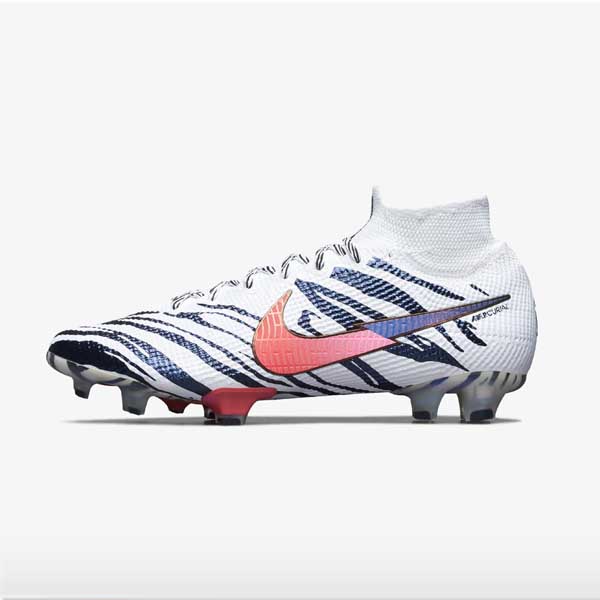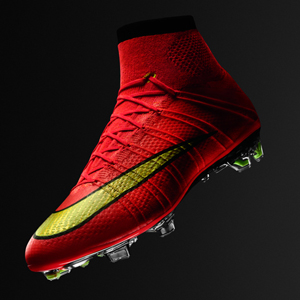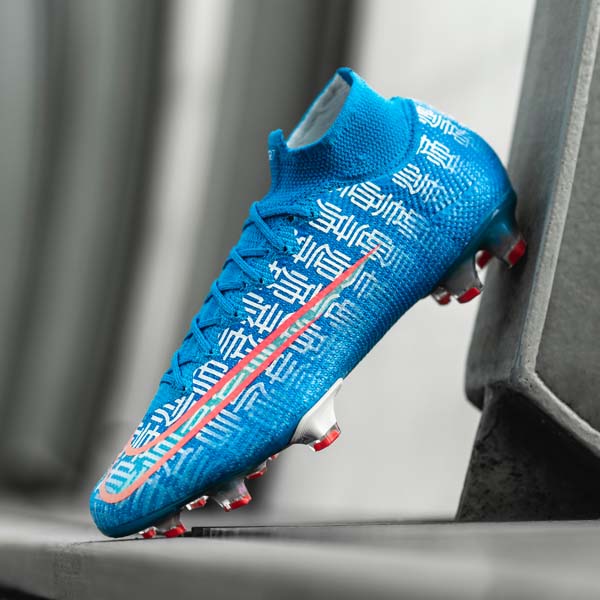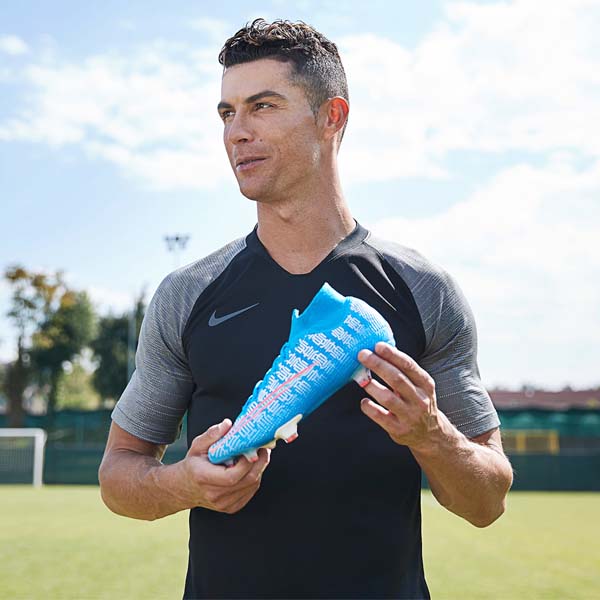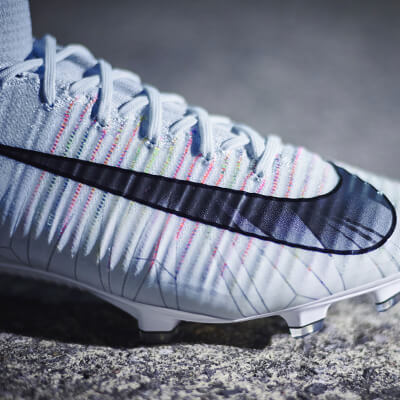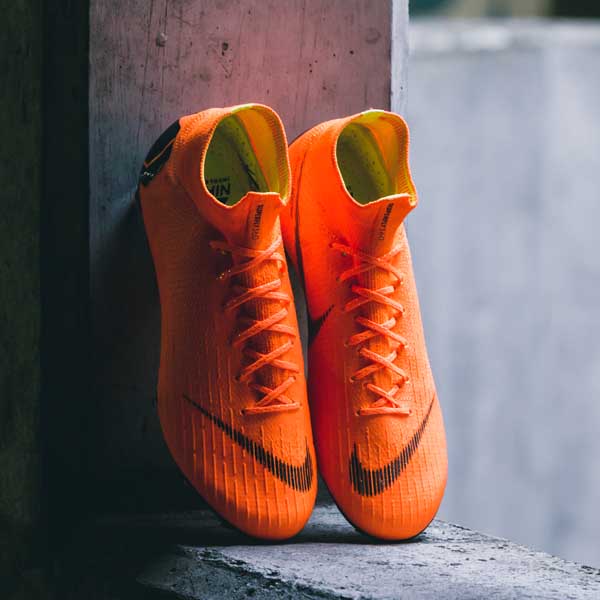Nike Mercurial Superfly II - Meet the Designer

For football boot fans, he has arguably the best job in the world. Meet Andy Caine, the Design Director for Nike and the man responsible for the latest Superfly II soccer cleats. At the launch of these new football boots, Andy was flown over from Nike's global HQ in Portland, Oregon to be part of the presentations and share some of his thinking and innovations around the boot design process.
In front of a wall of Superfly II football boots,the SoccerBible had an audience with Andy to discuss boot technology, design ideas and how many prototypes it takes to make the ultimate football boot.
What are the big improvements on the Superfly II over the previous edition?
AC: The real story is a lot of the traction elements; obviously the extending stud is huge, but equally important is the idea of the toe traction. It s an area that, in football design, hasn t really been addressed. You look at track spikes in other sports, a lot of other athletics use tracks on the toes to give you that extra last bit on the toe. So bringing that to football is also very unique.
The other thing that we ve really evolved is the redesign of the traction pattern. More braking, accelerating. These players are very creative and do a lot of different types of movement. So the traction pad is designed to give these creative, fast players the best traction in every type of movement that they re going to make.

We've read much speculation about the new stud - this extends by 3mm on the Superfly II which sounds like nothing! Why it can make such a difference?
AC: On boot like this we know that the biomechanics of a player are going to make them really focused on the forefoot. If you speak to most fast players, like Pato, they will literally tell you "this is the part of the foot I use when I m standing still". So the position of these two studs is where they re going to have the most impact. As you re toeing off on that first step acceleration they re positioned around there.
We measured accelerating and most of the force on the boot is put on there. Which means, if you re going to slip - that s when you re going to do it. The studs are located in areas where slippage might happen, and stop it happening. 3mm is a big difference on a football boot, it s not a small size when it comes to football.

How does the stud work? Does it interact with the surface?
AC: It s one-on-one with the player, and surface interaction reacts instantly. If it really requires a hard surface, it s just a normal boot. But if you put your foot in this orefoot sole area and press it, it has the ability to extend.
Are you a footballer yourself? Did you try the Superfly II out?
AC: [Laughs] Not as good as any of these players! Yes - one of the things about being a designer is you re naturally very curious about how it feels and how it fits. It s part of your job to know how it feels on your foot. The new traction system also makes this the most comfortable Mercurial Vapor we ve ever made - the pressure distribution is very even across the bottom.
One of the distinctive things with new Nike boots are the launch colours - do players have influence here?
AC: The colour really comes from a little bit of science. The idea was we talked about this visual acuity idea, and purple we know from the footballs, works with yellow - obviously the high-vis balls are yellow and purple. So we took that, as well as with a darker colour. So when you re running you get this colour change from one foot light purple to the other foot being dark purple and with that bounced off the grass, you get what we call a flicker which really engages players' peripheral vision. There s a lot more science behind it that just picking a colour!

Were there any developments from the Superfly II that were lead by a specific player?
AC: Yes, a lot of them were. We work with a lot of players and as said there were some very common themes that come out. The colour thing really came from Didier Drogba - his team mates were really noticing it. We brought it up with a lot of other players who d worn that boot, and they backed up what he was saying. Drogba has a real affinity for understanding all the little things about football boots, and I think also Cristiano Ronaldo and Zlatan Ibrahimovic also have this approach to looking at boots that s like Hey - what if… that s like they re almost challenging us to say "If we could do something here - what would it be?".
There are similarities between what players say, but there are also specifics, and Drogba comes to mind the most. Take Alexandre Pato, who s young and eager to try anything to be better. He's very demanding of what a boot can offer him to make him better.

What prompted the focus now on traction - what makes it so important?
AC: If you look at the stats or just watch a football game - if someone slips if you re a defender or attacker it s a big thing. If you re a defender and you slip then the attacker can get in. If you re an attacker who slips then you lose your chance. So I think that s really important - when you look at Ronaldo or Pato type players, they re extremely fast and dynamic and with game-changing moments, you don t want them to lose any of those moments.
So traction for them is super-critical. And part of the traction is the upper, it s got to lock you in otherwise you ll lose your efficiency. And that s no good either!
Do you get individual requests or modifications from players? Do you get many strange requests?!
AC: I don t think we ve had any strange requests. They re actually pretty serious about the boots, the players, for them it s part of their job. They re actually more serious than you may expect, as a better boot makes them better players, and the better boot we can make for the better it is for them, so the relationship with us and the players is actually very good.
That s why I spent 65 days last year travelling to meet these type of players. They re very busy people, so they respect that by working with us they can get a better product and become better players.

Who are some of the key players involved? How many altogether?!
AC: Drogba, Ronaldo, Zlatan, Pato, Eduardo, Theo, Bendtner, Ryan Babel - there s a lot! We don't just go to one player, that doesn t give you the breadth. We prefer to go to many players, see where the commonalities are, see what s unique and if that s something we can explore and see if that works out. You look for the things that are the most common, because if you improve that you help everyone.
How do you test a boot like the Mercurial Superfly II?
AC: We do all sorts of testing - lab testing for durability where we ll test how strong the boots are with puncture tests, pressure tests, we ll to internal pressure tests and slow-motion filming, we ll do traction testing and also on-pitch real life testing around the globe to get different perspectives, and we do that a lot.
I m a designer but we have use of an amazing facility in Portland. Working with those guys and also biomechanical specialists looking at what we re doing. When you get the specialists saying they re perfect, we ll take them back again to see if we can get it even better. That s why there were 43 prototypes - the experts were saying they were good to go on around 35, but we took it back in to see if we could get it even better. There s a lot of testing that goes in. Football boots have to be worn, at the end of the day. Athletes are wearing them 3, 4,5 hours a day 7 days a week - they have to be right.

So could you have Ronaldo do the speed challenge test in the old model, then have him switch to the new Mercurial Superfly II and he would be faster?
AC: Yes!
As a designer, which of the new innovations are you most proud of?
AC: It has to be the stud - if you understand industrial design and the complexity in producing something that actually moves on a football boot - is beyond complex. We actually spent a lot of time and energy to make it work and to me; it is the be-all and end-all. I m pretty stoked about that - but there is a lot more just on this boot in itself! The colour s pretty cool, I m pleased with how it turned out - it is a good evolution from the last model, pretty much a revolution from the last boot.

How long is a boot like this development?
AC: Depends on the silo, theres different lengths to different products from Nike - it ranges from 18 months to around 4 years. It really depends on the market. We started developing this boott 2 and a half to 3 years ago.
How many prototypes have you seen in the development cycle?
AC: A lot! Just as an example, on the upper alone we made around 43 different versions of the upper to get the right one. Every one goes through the Nike Sports Research Lab (in Portland, Oregon) where we slow motion film the testing of every boot to ensure the foot is staying in the right place. The studs, however, are made in 5 big steps and there s been a lot of changes to those steps! To create a boot like this is very complicated - it takes a lot of time and a lot of testing. Around 2 years of testing went into this boot.

What do you do on Day 1 when you're designing a new boot?
AC: The start of the process is sort of having that vision, an idea of what you want to produce. In this boot the vision was to create the fastest boot possible, but also take speed into the next generation. The idea of adaptability came from the first part of that brief, what can we bring to change the game and what are speed boots all about. There's not much sketching at this point - it is a lot more about mentaility, what do we want to achieve. Once we have this vision - the dream as I call it - then we can start putting things into action. Sketching, prototypes, re-sketching, more prototypes...
You've designed two editions of the Mercurial series, do you work with any of the other silos within Nike?
AC: I'm in charge of football design, helping give direction to the team. Having been involved with Mercurial I was also heavily involved in the CTR360 design. It's a great job!
